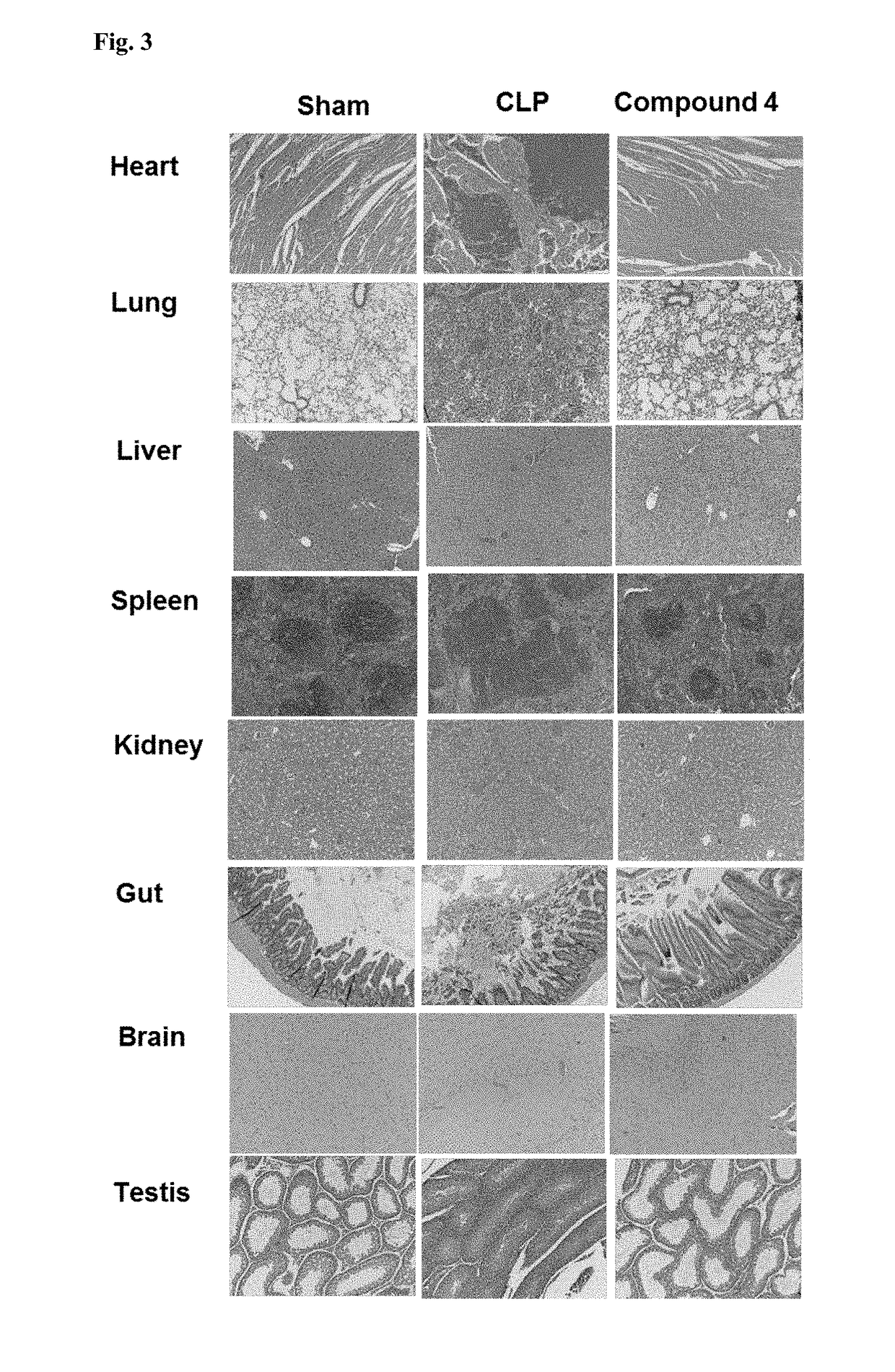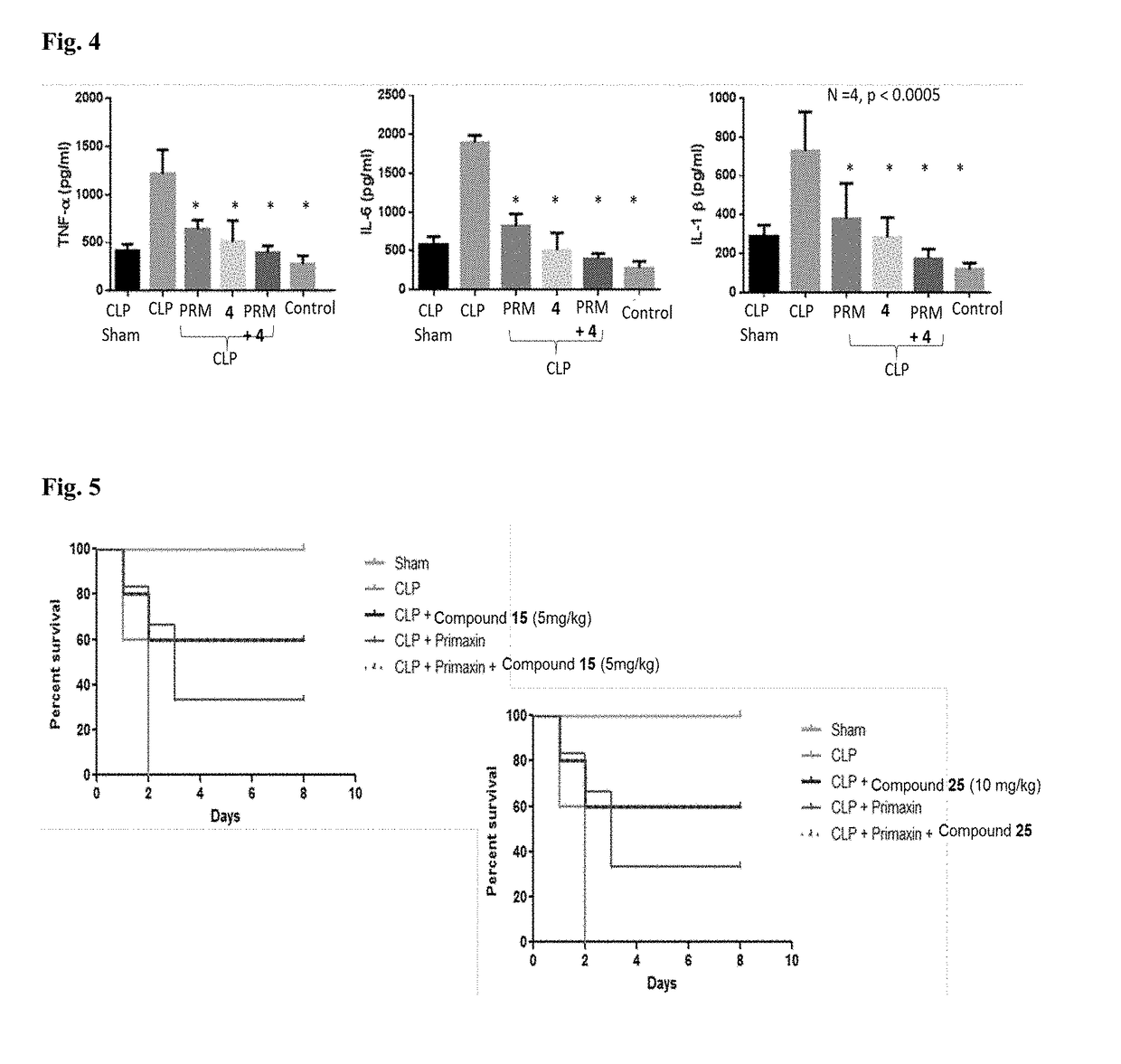Novel compositions and therapeutic methods
a composition and composition technology, applied in the field of new compositions and therapeutic methods, can solve the problems of imposing a large economic burden on healthcare systems worldwide, unable to completely treat patients with sepsis and septic shock, and unable to completely eliminate current therapies, etc., to achieve superior anti-inflammatory activity, superior activity, and superior in vivo efficacy in protecting mice
- Summary
- Abstract
- Description
- Claims
- Application Information
AI Technical Summary
Benefits of technology
Problems solved by technology
Method used
Image
Examples
example 1
A Series of Compounds of Present Invention Binds to TLR4 Receptor Effectively and not to TLR2 Receptor:
[0116]ELISA plates were coated with human monocyte lysates (isolated from commercially available LeukoPak blood sample) followed by an array of compounds (10 μM) as shown in FIG. 6. It was then incubated with human monocyte lysates and then probed with anti-TLR4 and anti-TLR2 antibodies. Plates were developed using anti human IgG-HRP positive control. Compounds 1-3, binds to TLR4 receptor effectively and not to TLR2 receptor. Greater chain length analogs showed stronger antagonism (FIG. 7A). Similarly, other analogs were assessed for TLR4 antagonist assay as shown in FIG. 7B. Briefly, 0.5 million cells were grown in RPMI with 10% FBS O / N in two 24 well plate. Next day, the media was taken out without disturbing the lower layer and different concentration of compounds were added to make total amount of 0.5 ml volume with RPMI which was incubated for 48 hrs. Cells were harvested and ...
example 2
Compounds were Tested for Inhibiting the Production of Inflammatory Mediators in Human Monocytes
[0117]To understand the structural requirement and limitations to probe the TLR4 binding pocket for optimal potency and efficacy, we have studied the ability of chitooligomers to inhibit LPS induced inflammation in human monocytes (FIG-8 A-B). Compounds 1-4 inhibited LPS induced cytokines TNF-α, IL-1β and IL-6) in a statistically significant manner at 10 μM concentration. Compound 2 and 4 (10 μM) were found to be more potent than chitohexaose, (Compound 1) (10 μM) in terms of percentage of inhibition of LPS mediated induction of inflammatory cytokines (LPS vs Chtx pPLoS Pathog 2012, 8, e1002717]. Human monocytes were stimulated with LPS along with the series of compounds (10 μM) for 48 h. TNF-α, IL-1β, I1-6 in culture supernatants were quantified according to the manufacturer's instruction. Similarly, other analogs were assessed for their ability to inhibit LPS induced TNF-α production in...
example 3
Compounds 1, 2, and 26 Inhibits LPS Induced Production of Inflammatory Mediator (TNF-α) in Mouse Bone Marrow Derived Macrophages:
[0118]Bone marrow derived mouse macrophages were treated with 100 μM of the above test compounds for 8 hours. Pro-inflammatory cytokines such as TNF-α protein level was measured by real-time RT-PCR. LPS treatment (10 ng / ml) was used as positive control (FIG. 9).
PUM
| Property | Measurement | Unit |
|---|---|---|
| Mass | aaaaa | aaaaa |
| Mass | aaaaa | aaaaa |
| Mass | aaaaa | aaaaa |
Abstract
Description
Claims
Application Information
 Login to View More
Login to View More - R&D
- Intellectual Property
- Life Sciences
- Materials
- Tech Scout
- Unparalleled Data Quality
- Higher Quality Content
- 60% Fewer Hallucinations
Browse by: Latest US Patents, China's latest patents, Technical Efficacy Thesaurus, Application Domain, Technology Topic, Popular Technical Reports.
© 2025 PatSnap. All rights reserved.Legal|Privacy policy|Modern Slavery Act Transparency Statement|Sitemap|About US| Contact US: help@patsnap.com



